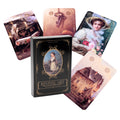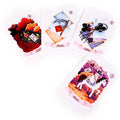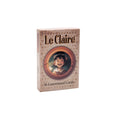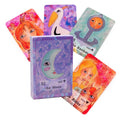Sidebar
Tarot card reading
The earliest evidence of a tarot deck used for cartomancy comes from an anonymous manuscript from around 1750 which documents rudimentary divinatory meanings for the cards of the Tarocco Bolognese.[18][19] The popularization of esoteric tarot started with Antoine Court and Jean-Baptiste Alliette (Etteilla) in Paris during the 1780s, using the Tarot of Marseilles.[20] French tarot players abandoned the Marseilles tarot in favor of the Tarot Nouveau around 1900, with the result that the Marseilles pattern is now used mostly by cartomancers.
Tarot decks in occult usage
Etteilla was the first to issue a tarot deck specifically designed for occult purposes around 1789. In keeping with the misplaced belief that such cards were derived from the Book of Thoth, Etteilla's tarot contained themes related to ancient Egypt.[20]
The 78-card tarot deck used by esotericists has two distinct parts:
The Major Arcana (greater secrets), or trump cards, consists of 22 cards without suits:
The Magician, The High Priestess, The Empress, The Emperor, The Hierophant, The Lovers, The Chariot, Strength, The Hermit, Wheel of Fortune, Justice, The Hanged Man, Death, Temperance, The Devil, The Tower, The Star, The Moon, The Sun, Judgement, The World, and The Fool. Cards from The Magician to The World are numbered in Roman numerals from I to XXI, while The Fool is the only unnumbered card, sometimes placed at the beginning of the deck as 0, or at the end as XXII.
The Minor Arcana (lesser secrets) consists of 56 cards, divided into four suits of 14 cards each;
Ten numbered cards and four court cards. The court cards are the King, Queen, Knight and Page/Jack, in each of the four tarot suits. The traditional Italian tarot suits are swords, batons, coins and cups; in modern occult tarot decks, however, the batons suit is often called wands, rods or staves, while the coins suit is often called pentacles or disks.
The terms "Major Arcana" and "Minor Arcana" were first used by Jean-Baptiste Pitois (also known as Paul Christian) and are never used in relation to tarot card games. Some decks exist primarily as artwork, and such art decks sometimes contain only the 22 major arcana.
The three most common decks used in esoteric tarot are the Tarot of Marseilles, the Rider-Waite-Smith tarot deck, and the Thoth tarot deck.[20]
Aleister Crowley, who devised the Thoth deck along with Lady Frieda Harris, stated of the Tarot: "The origin of this pack of cards is very obscure. Some authorities seek to put it back as far as the ancient Egyptian Mysteries; others try to bring it forward as late as the fifteenth or even the sixteenth century ... [but] The only theory of ultimate interest about the Tarot is that it is an admirable symbolic picture of the Universe, based on the data of the Holy Qabalah.
Tarot decks in occult usage
Etteilla was the first to issue a tarot deck specifically designed for occult purposes around 1789. In keeping with the misplaced belief that such cards were derived from the Book of Thoth, Etteilla's tarot contained themes related to ancient Egypt.[20]
The 78-card tarot deck used by esotericists has two distinct parts:
The Major Arcana (greater secrets), or trump cards, consists of 22 cards without suits:
The Magician, The High Priestess, The Empress, The Emperor, The Hierophant, The Lovers, The Chariot, Strength, The Hermit, Wheel of Fortune, Justice, The Hanged Man, Death, Temperance, The Devil, The Tower, The Star, The Moon, The Sun, Judgement, The World, and The Fool. Cards from The Magician to The World are numbered in Roman numerals from I to XXI, while The Fool is the only unnumbered card, sometimes placed at the beginning of the deck as 0, or at the end as XXII.
The Minor Arcana (lesser secrets) consists of 56 cards, divided into four suits of 14 cards each;
Ten numbered cards and four court cards. The court cards are the King, Queen, Knight and Page/Jack, in each of the four tarot suits. The traditional Italian tarot suits are swords, batons, coins and cups; in modern occult tarot decks, however, the batons suit is often called wands, rods or staves, while the coins suit is often called pentacles or disks.
The terms "Major Arcana" and "Minor Arcana" were first used by Jean-Baptiste Pitois (also known as Paul Christian) and are never used in relation to tarot card games. Some decks exist primarily as artwork, and such art decks sometimes contain only the 22 major arcana.
The three most common decks used in esoteric tarot are the Tarot of Marseilles, the Rider-Waite-Smith tarot deck, and the Thoth tarot deck.[20]
Aleister Crowley, who devised the Thoth deck along with Lady Frieda Harris, stated of the Tarot: "The origin of this pack of cards is very obscure. Some authorities seek to put it back as far as the ancient Egyptian Mysteries; others try to bring it forward as late as the fifteenth or even the sixteenth century ... [but] The only theory of ultimate interest about the Tarot is that it is an admirable symbolic picture of the Universe, based on the data of the Holy Qabalah.












































Tarot Reader in Dubai
Tarot card reading is a deck of tarot cards to give your insight and clarity into your life. You can consult with Humeira Tarot card Reader in Dubai who is the best tarot card reading in Dubai.